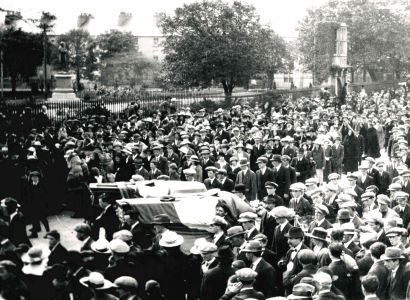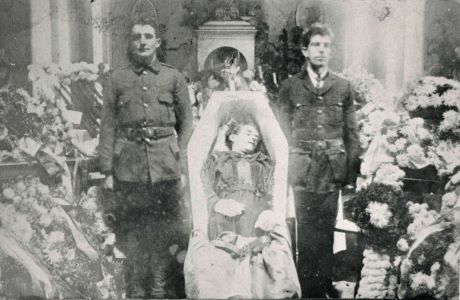A VIOLENT NIGHT IN GALWAY

by Tom Kenny
Edward Krumm was 5’ 11”, 26 years old, a bachelor and a member of the Church of England from Middlesex. He was a lorry driver with the Black and Tans and had been in Galway three weeks when he arranged to meet a civilian driver he had come to know in a pub in Abbeygate Street. This man, Christopher Yorke, described Krumm as a “generally reckless fellow who drank a lot”. Krumm was fairly drunk brandishing a revolver and bragging that he could knock the neck off a bottle at ten yards range, and apparently shot at a few bottles in the pub.
Krumm and Yorke then went to Baker’s Hotel in Eyre Street where the barmaid heard Krumm suggest to Yorke that they should go to the station to get an evening paper as he wanted to see the results of the St. Leger which was run that day and in particular, how a horse named Spion Kop did. The word had gone out about a drunken Black and Tan heading for the station and the local IRA decided that they would try to take his gun from him.
In those days, the evening papers would come in on the train at about 10.30pm and a lot of people would be waiting there to buy a copy. As it happens, Mícheál Ó Droighneáin and Tom Redington were on the train smuggling in arms and ammunition with a view to an attack on Spiddal RIC Barracks.
There are a number of versions of what happened on the platform. Krumm was certainly waving his gun around. The authorities said he was ‘gunned down in a shooting confrontation with the IRA, that the IRA went to take his gun and that he opened fire in self-defence’. Some said that as people rushed forward to get the papers, krumm was pushed and started firing. An American lady, Mrs. King who witnessed the fracas said that Krumm was “Standing with an ordinary man in ordinary clothes. He was slashing his gun around and began shooting. While an army man nearby tried to protect a woman and her three children, Krumm shot a young man in the leg. It was at this point that (Sean) Mulvoy a Volunteer, went to help the wounded man but Krumm shot him. Then another boy (Seán Turke) jumped from the back and caught the soldier across the body so that he only had one hand free. Then a shot rang out (from Volunteer Frank O’Dowd) and the soldier fell to the ground”
Another version suggests that Krumm was firing indiscriminately when Turke and Mulvoy jumped on him and as they wrestled, Krumm’s gun went off and killed Mulvoy. Whatever happened, Tommy Fahy and Mike Hynes took Krumm’s gun, went out the back way from the railway station and hid the gun under some timber at the docks. Mulvoy was taken to O’Leary’s house in Forster Street where he received the last rites.
While all of this was going on, Mícheál Ó Droighneáin and Tom Redington were unloading the smuggled arms at the other end of the train.

Krumm died at about 1am. In Eglinton St. Barracks, many of the men were asleep in bed when one of the constables rushed in shouting about the killing. There were about 50 men stationed there and they quickly dressed, armed themselves and went out at about 2.30am to take revenge. They fired their rifles, attacked homes, beat the occupants and set buildings on fire. The above mentioned Mrs. King took refuge in the hotel where a British Officer assured her that “Only townspeople who deserved to be shot were being shot”.
The Tans attacked the offices of the Galway Express newspaper in Eyre Square and smashed up the printing machinery (the damage was reckoned at about £3,000) but the staff managed to get out a special edition the next day. Seamus Quirke, a Volunteer, had been at the pictures that night with Fred Bray. The Tans went to the home of his landlady, Mrs. Burbidge, on the docks and dragged him 200 yards along the docks and shot him 9 times in the stomach and once in the spine. He was left for dead but managed to crawl back to his lodgings where Fr. Griffin administered the last rites. He died in agony about 30 minutes later. Thomas Walsh’s pub on Eyre Square north was set ablaze, but the military arrived to put the fire out. The Tans also went to Mrs. Madden’s house on St. Brendan’s Terrace and attacked and beat Thomas Fahy and Martin Commins, both of whom worked in Brennan’s Drapery, then took Commins to the station.
The Tans also went to Johnny Broderick’s house on Prospect Hill and dragged him out of bed, before setting the house on fire but neighbours gathered to extinguish the blaze. They brought Broderick to the station and lined him and Martin Commins up against the large sliding door which opens on to the platform. A firing squad was formed but they were either drunk or just bad shots … they managed to shoot Commins in the leg and graze the head of Broderick with a bullet. Both fell to the ground and feigned death and the Tans left. Commins went into hiding and Broderick went to a safe house in Forster Street and later to Mayo to lie low for a time. Seán Turke also went on the run. Twelve bullet holes were found in the station door the following day.
The President of the Court of Enquiry refused to pass judgement on what had precipitated the events at the station, “There is no actual proof of what occurred regarding the shooting” he said. Krumm’s mother was paid £2,100 compensation for his killing plus £100 for funeral costs. An estimated 10,000 people turned out for the joint funerals of Quirke and Mulvoy. Mulvoy was buried in Mervue, and Quirke’s remains were taken back to his native Cork.
Our photographs show the joint funerals of Quirke and Mulvoy and also the body of Seamus Quirke in his coffin flanked by two Volunteers, Seán Turke being the one on the right. These events took place on the night of September 9th/10th, 1920, one hundred years ago next Wednesday.
.png)